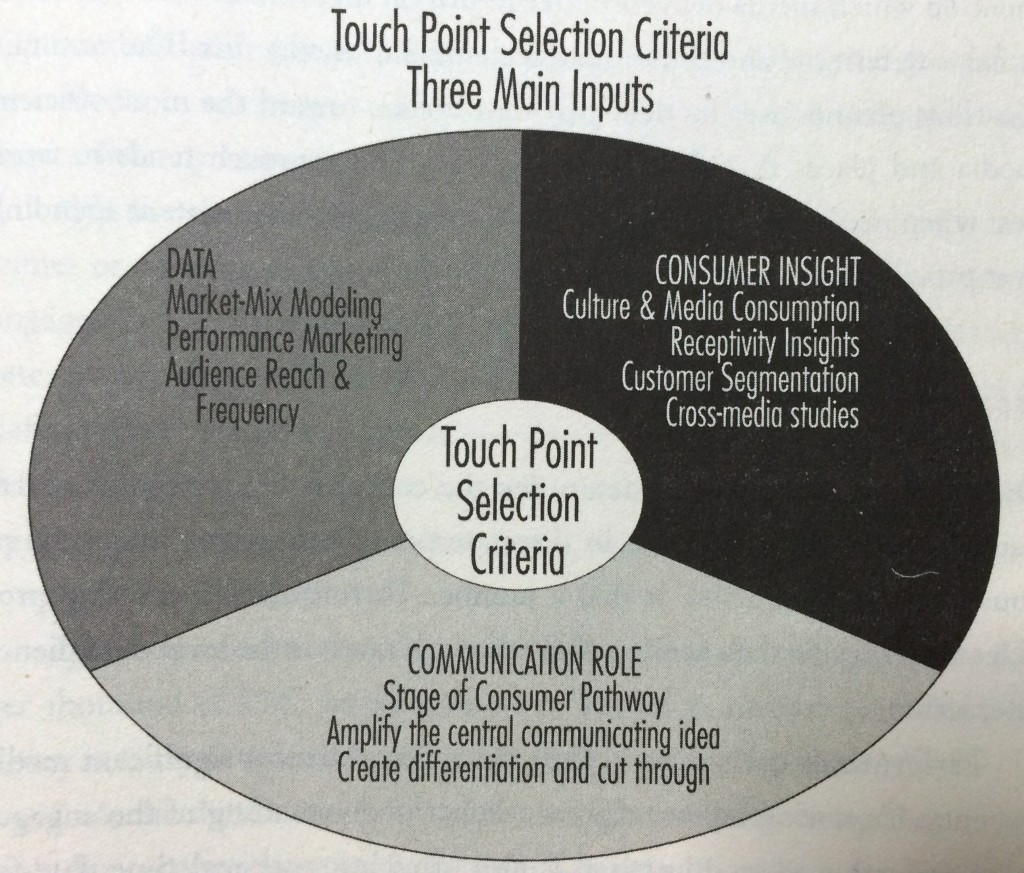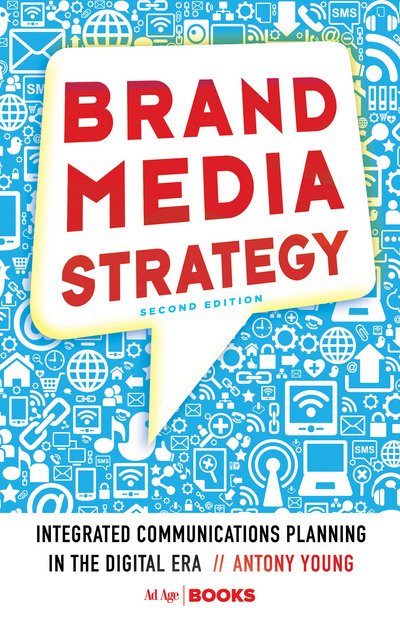How do we combine the discipline of media planning with cutting edge developments in the digital age?
Well, Antony Young of the Water Cooler Group seem to have the answer. In the second edition of his book Brand Media Strategy, Antony delves deep into the discipline of integrated communications planning, showing us how we can develop a strategic and holistic plan to drive brand marketing across all media touch points – traditional, experiential, digital and word of mouth.
Packed with a framework, tools, and numerous case studies in communications planning, Brand Media Strategy covers a wide range of topics. They include consumer behaviour, research, social media, digital and mobile media, influencer engagement, conversational marketing, transmedia storytelling, big data and analytics.
Let me highlight salient lessons from the book.
Consumer Pathways and Insights
A key part of the book focuses on mapping out Consumer Pathways, and obtaining in-depth customer insights. Typically, this broadly includes current cultural and media trends, data on category, brand and product, views provided by opinion leaders, as well as consumer behaviours.
A Consumer Pathway comprises stages of brand influence: awareness, involvement, active consideration, purchase, consumption, relationship building and advocacy. An example of a consumer pathway and accompanying insight is seen below:

Courtesy of new or not
In determining how and where media can help, Young proposes that the “brand actions” that communication planners should work for ought to be outcome based (eg “Get noticed”, “Close the deal”, or “Make them feel special”) rather than output based (ie indicators like reach, frequency, impressions, gross rating points or GRPs, and cost per response).
Integrated Communications Planning
With the consumer pathway in mind, media planners should put together an integrated communications plan comprising the following:
- A Central Communications Platform (CCP) which is described as the big brand idea allowing us to anchor and integrate the Brand Media Strategy with all its media activations. This is not the advertising tagline per se, although it can incorporate a creative idea. An example is Axe body spray’s “The magic promise of mating game success”.
- Communication Goals which spell out what the key communication outcomes are.
- An analysis of the selected customer via Consumer Insights. These could take reference from the consumer pathway earlier mentioned.
- Determining Moments of Receptivity (ie the right contexts for messaging).
- Selecting the right Campaign Architecture (ie key messages, platforms, schedules, etc)
- Amplifying the Idea via generating buzz and conversation amongst Influencers.
- Activating the Plan by executing it well.
Like the conductor in an orchestra, weaving the various communication elements together require multi-talented “T-shaped” folks who can combine depth of knowledge in one marketing discipline (eg media, digital or creative) with a breadth of understanding.
A good way to visualise the Communications Plan is seen in the Brand Media Strategy Wheel below.

Brand Media Strategy Wheel (courtesy of Brand Media Strategy)
Actionable Insight Over Analysis
Throughout the book, Young emphasises the importance of uncovering brand media insights related to the receptivity of the target customer at the point of time (ie his or her specific context). Sources of insights can cover anything from consumers, markets, culture, brand, product category, future trends, usage patterns, purchase and ownership.
These can be unearthed through studying prevailing cultural and pop trends, talking to experts, observing what people do (ethnographic research), hitting the streets, journaling, and mining digital data. Thereafter, insights should be filtered and tested by asking probing questions to discern what they truly reveal before putting them into action.
Word Of Mouth and Influencer Marketing
With friends and family recommendations topping the list of “most influential touch points on purchase”, brands should strive to generate word of mouth recommendations. To generate such brand conversations, the following steps can be considered:
- Start by listening – both online and offline – to what customers are saying.
- Talk to the talkers, ie employees, fans and influencers.
- Begin conversations with an idea (this can be the CCP which I wrote about earlier).
- Make it worth their while to share.
- Amplify the conversation in paid media. Despite what naysayers may be saying, mainstream advertisements on TV and newspaper still work if done properly.
- Budget for production and ideas.
- Measure sensibly.
A key part of this involves working with influencers of various categories – business decision-makers and opinion leaders, recognised experts and analysts, media elite, cultural elite, and the socially connected. In the social world, they may be anybody with a significant social media presence on blogs, video sharing sites, or social networking platforms.
Selecting the Right Touch Points
In determining the right touch points to be used, three key inputs are considered: data, consumer insight, and communication needs:
- Data here covers stuff like the market-mix or econometric modelling, ie the ratio of the different media channels used, past performances of various media (eg click-through rates), reach and frequency;
- Consumer Insights include media consumption, customer demographics, behaviours, and other attributes (see earlier section);
- Communication Roles encompass the stage of the consumer pathway, the central communicating idea (ala the CCP), and developing a way to break through the clutter via differentiation.
These can be represented by the diagram below (extracted from the book):

Touch Point Selection Criteria (courtesy of Brand Media Strategy)
Digital, Social, Mobile and Big Data
Throughout various chapters in the book, Young elaborates on the significance of technological trends and their impact on media planning. They include the following observations:
- How 800 pound gorillas Google and Facebook transform the way people are influenced by and search for brands.
- The shift from broadcast to broad “catch”, requiring brands to make their messages appear in the right contexts for consumers across multiple screens.
- A world where everybody is a media company, and where micromedia (ie a short video on YouTube as opposed to a television series) and social media makes Word Of Mouth (WOM) marketing more scalable.
- Search is now the last mile of marketing. Google termed this the “Zero Moment of Truth” (ZMOT).
- Real-time or Adaptive Marketing allows brands to tailor their market activities in fluid ways to respond to evolving customer interests and events based on data. Think news-jacking and trend-jacking.
- Big Data allows brands not only to predict consumer behaviours but to micro-target them based on their unique online behaviours, networks, interests and transactions. Media planners can opt for programmatic buying, ie a more automated and algorithmic buying and selling of media platforms based on their correlation to reach, audience, and behaviours.
Execution and Activation
Calling execution the “X-factor” leading to the success of campaigns, the book elaborates on some of the “Dos” and “Don’ts” of implementing the Communications Plan. A key part of this lies in briefing one’s media partners (digital, social, creative, PR, etc) with an integrated activation brief. An example of such a brief is highlighted below:
The Integrated Activation Brief
- Product and brand background
- Who are the customers?
- Campaign goals: Business and communication goals; What are we trying to achieve? What stages of the consumer pathway are we trying to influence?
- Campaign strategy: A central consumer, brand of business insight; The CCP or strategic platform; The creative idea; Areas of receptivity
- Specific role of the channel identified
- Metrics to measure success
- Provision of initial tactics as guidelines
- Budget
- Timing
Measurements and KPIs
Finally, towards the end of the book, Young dived deeply into the worlds of metrics, analytics and Big Data.
Using the Consumer Pathway as a tracking device, the book proposes that the Key Performance Indicators (KPIs) should be calibrated to match the communication challenge that the plan seeks to address. These could range from ad and brand awareness, brand affinity, purchase consideration, actual purchase volume, to customer satisfaction, repeat purchase rate and net promoter scores. A key thing to remember here is that the best campaigns are focused on just two to three KPIs at the most.
To ensure that these are well considered, we should ask the following:
- Are the KPIs aligned to communication goals?
- Do we have established benchmarks to set meaningful goals?
- How can the data help me steer or change the plan?
An Invaluable Resource and Guide
Comprehensive and detailed, Brand Media Strategy covers a wide spectrum of issues concerning the art and science of communications and media planning. Written from the trenches of an experienced media planner, it doesn’t just “poo-poo” traditional media with the advent of digital, but seeks to incorporate both in a holistic new fashion. I’d strongly recommend that you give this book a spin if you are a media planner, consumer researcher, marcoms specialist or publicist.
30% Book Discount for Cooler Insight Readers
This blog post was made possible with a review copy from Palgrave Macmillan. Readers of Cooler Insights can enjoy a 30% discount on books ordered from Palgrave Macmillan’s website using the promotional code PM14THIRTY. Just log on to their website and check out their wide selection of professional, business and other titles.


One Comment